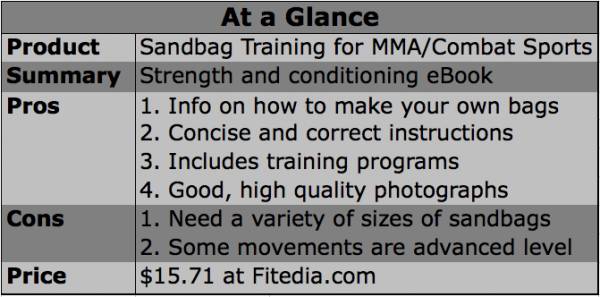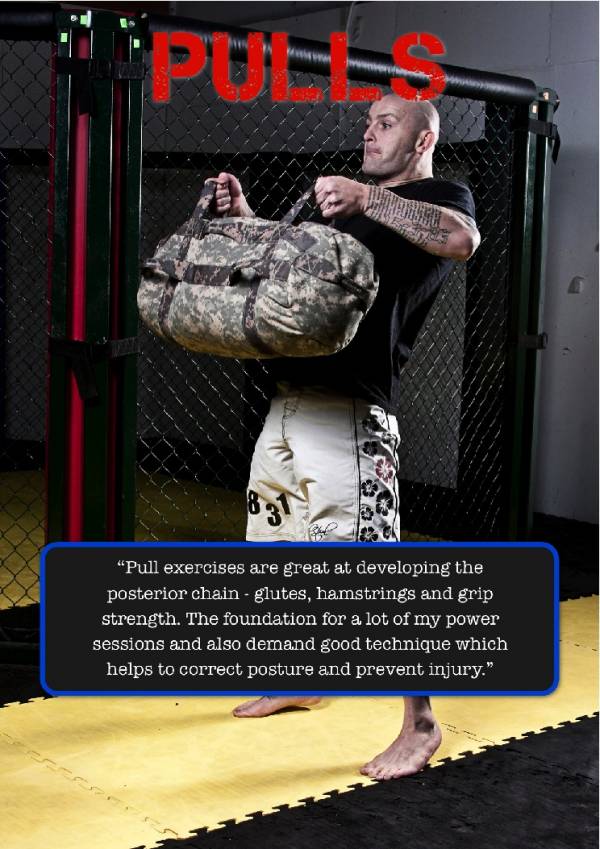
My initial thought prior to reading Sandbag Training for MMA & Combat Sports was “Here we go again, 194 pages of complicated, rehashed stuff from the past that is nothing new and probably impractical to implement.” But I was wrong. This book (available in both electronic and paperback form) is loaded with tons of useful exercises. It is straight-forward, well-organized, and surprisingly easy to read.
Part one sets the stage. It gives you a heads-up on forthcoming content and what to expect from undertaking sand bag training. Included are basic preparation, how to make your own bags, where to purchase quality bags, and easy-to-follow pre-workout warm up exercises.
Part two offers the specifics on sand bag exercise performance. It is not the typical perfunctory overview on how to perform exercises. It has concise, step-by-step instructions on fantastic exercises. The photographs that accompany the  exercise descriptions seal the deal as they clearly depict proper exercise techniques.
exercise descriptions seal the deal as they clearly depict proper exercise techniques.
The “Fighter’s Tips” included at various points are a bonus. To read what an actual MMA fighter feels about the value of certain exercises and how they implement them merges science to the ring. The practical application of the exercises is well confirmed.
Part 3 is the meat and potatoes of the book. It puts it all together in terms of program examples, workout prescriptions, and the variety of exercises that can be implemented. The strength training workouts are simple to understand and perform. They are sensible in terms of training days, recovery days, and time allowed for work on other important skills.
Also included are conditioning workouts which are categorized as follows:
- Power
- Speed and agility
- Endurance
- Fighter-specific
The power, speed and agility, and endurance programs are also easy to understand and implement. The fighter-specific workouts are dead-on because they replicate the actual energy demands of a MMA contest. I am not a big sport-specific guy relative to the transfer of skills from one activity to another (clearly read the motor learning research), but the energy system replication is viable.
The balanced program was the best take-home information in the book. It entails a combination of the strength, power, and endurance programs scheduled over a three-day per week plan. This allows for not only a variety of training modes, but the necessary recovery time between these high-intensity sessions.
Overall, I liked the basic three days per week training format, the low-volume exercise prescriptions, and the variety of exercises offered. This allows for quality training time, yet enough time for recovery and skill-training needs.
The icing on the cake is the last FAQ’s section. Any concerns or issues one has is resolved here. Palfrey and Murch do not leave you hanging. One important point is they let it be known that this is not solely for MMA and combat sport participants, but it can be used for anyone interested in adding a new twist to their training.
My only concerns with the book are these:
- One would need a variety of sand bag sizes depending upon the exercise performed and one’s ability. The recommendations of light, medium, and heavy are subjective. One size does not fit all.
- Some of the full-body exercises are advanced and thus challenging. The average Joe or Jane may find it difficult to perform some of those exercises. Be cautious, and don’t attempt these until you obtain the required experience.
- Similar to other conventional strength training exercises, initial trial and error is required to determine the proper sand bag weight to use on each exercise. Granted, this can be resolved within a few workouts.
In summary, I really like this book. For most trainees, it can be applied to their training even if not and an MMA or combat fighter. With a little work, all programs are understandable, able to be completed, and can add variety to any training program.
“Sandbag Training for MMA & Combat Sports” is available at Amazon.






